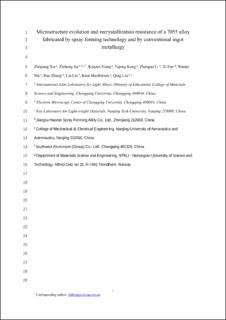Microstructure Evolution and Recrystallization Resistance of a 7055 Alloy Fabricated by Spray Forming Technology and by Conventional Ingot Metallurgy
Xie, Zhiqiang; Jia, Zhihong; Xiang, Kaiyun; Kong, Yaping; Li, Zhenguo; Fan, Xi; Ma, Wantai; Zhang, Hao; Lin, Lin; Marthinsen, Knut; Liu, Qing
Peer reviewed, Journal article
Accepted version

Åpne
Permanent lenke
https://hdl.handle.net/11250/2758043Utgivelsesdato
2020Metadata
Vis full innførselSamlinger
- Institutt for materialteknologi [2527]
- Publikasjoner fra CRIStin - NTNU [37703]
Originalversjon
Metallurgical and Materials Transactions A. 2020, 51 (10), 5378-5388. 10.1007/s11661-020-05931-wSammendrag
The effect of different fabricating processes (spray forming and conventional casting) and homogenization treatment on the microstructure of an 7055 alloy was investigated by optical microscopy (OM), scanning electron microscopy (SEM), electron probe X-ray micro-analyzer (EPMA), and transmission electron microscopy (TEM). It was found that the grain size of the as-deposited (spray formed) 7055 alloy had half the size as that of the as-cast 7055 alloy and there was no Al2CuMg phase that embedded in the coarse Mg(Zn, Cu, Al)2 phase distributed along the grain boundaries in the as-deposited 7055 alloy. No segregation of zirconium was observed in the as-deposited 7055 alloy. After homogenization heating at 350 °C/5 hours + 470 °C/24 hours, Al3Zr dispersoids were inhomogeneously distributed within grains in the traditionally cast 7055 alloy, while more homogeneously distributed within grains in the spray-formed 7055 alloy. Compared with the traditional cast 7055 alloy, the uniform distribution of Al3Zr dispersoids in the spray-formed 7055 alloy retards recrystallization more effectively. This investigation highlights the advantage of spray forming technology on improving microstructure of a 7055 alloy.